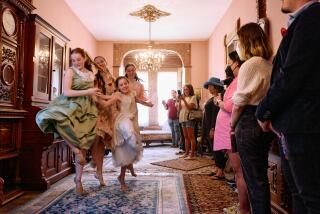A Contrast in Feminist Movement
- Share via
On paper, the program of solos scheduled by the locally based American Repertory Dance Company at the Japan America Theatre on Friday promised to be provocative but uncompromisingly downbeat: a survey of mostly sad, small-scale feminist modern dance from the last 30 years. However, the illness of dancer Nancy Colahan caused the deletion of works by Lar Lubovitch and Peggy Baker. In their place came Martha Graham’s familiar, audacious “Satyric Festival Song” of 1932, a statement of indomitable female energy and self-empowerment the evening otherwise lacked.
The contrast proved eloquent in itself: Graham’s heroic feminism from the first third of this century versus a dark and often grim vision from the last third by the rest of the choreographers. Take Carl Wolz’s weighty, ceremonial “The Widow” (1968), in which Toru Takemitsu’s sound score of screams and swirling wind bombarded company co-director Bonnie Oda Homsey as she walked a narrow path of light, periodically kneeling, reaching out in grief or toward the memory of something unrecoverable.
Also consider Wally Cardona’s “Blood/the last industrial” (1995), which began with Risa Steinberg idly daydreaming in movement to the accompaniment of a faraway pop record, then enacting a tortuous contemporary equivalent of “The Dying Swan” to a forceful percussion score by Jonathan Kane. Like the bleak life cycle evoked in “The Widow,” the journey here defined heroism through sheer endurance, with Steinberg ultimately down but not out as the lights and music faded at the end.
Steinberg again sustained a feeling of rapt, intuitive self-exploration in Colin Connor’s briefer, more fragmentary “Absence Is Never Far” (1996), to a violin-dominated score by Gavin Bryars. And Homsey brought deep contemplative gravity to the fusion of modern dance and traditional Polynesian movement in Earnest Morgan’s “Ku’u Home O’ Kahalu’u” (1979, music by Olomana) as if its concept of graceful womanhood belonged in a museum of endangered archetypes.
Besides dancing “Satyric Festival Song” with her usual throwaway brilliance, company co-director Janet Eilber took on Susana Tambutti’s half-hour tour de force “The Stab” (1985), which ricocheted between ironic vaudeville and the kind of grotesque gender transformations identified with early butoh master Kazuo Ohno and his followers. Call it movement theater, with actual dancing less important than the act of donning or discarding costumes and roles.
Whether putting on a hat in perfect Bob Fosse style or executing tricks with a veil that Salome never imagined, Eilber looked fabulous, but her most indelible moments came in passages where Tambutti divided her body, left and right, into male and female opposites, like a famous statue of the Hindu god Shiva on Elephanta Island near Bombay.
Staged in profile across a chair, these sequences made violence against women into an eternal ritual of self-destruction, with the predatory male half (gloved, overcoated) wielding his knife against the unsuspecting female half (barelegged, high-heeled) and, of course, killing himself as well. Through bold theater metaphor, Tambutti made you remember all those crazed ex-husbands who murder their former wives and themselves in almost the same impulse--and she also made you question whether “Till death do us part” really ought to remain a primal societal tenet in this very dangerous world.
More to Read
The biggest entertainment stories
Get our big stories about Hollywood, film, television, music, arts, culture and more right in your inbox as soon as they publish.
You may occasionally receive promotional content from the Los Angeles Times.










